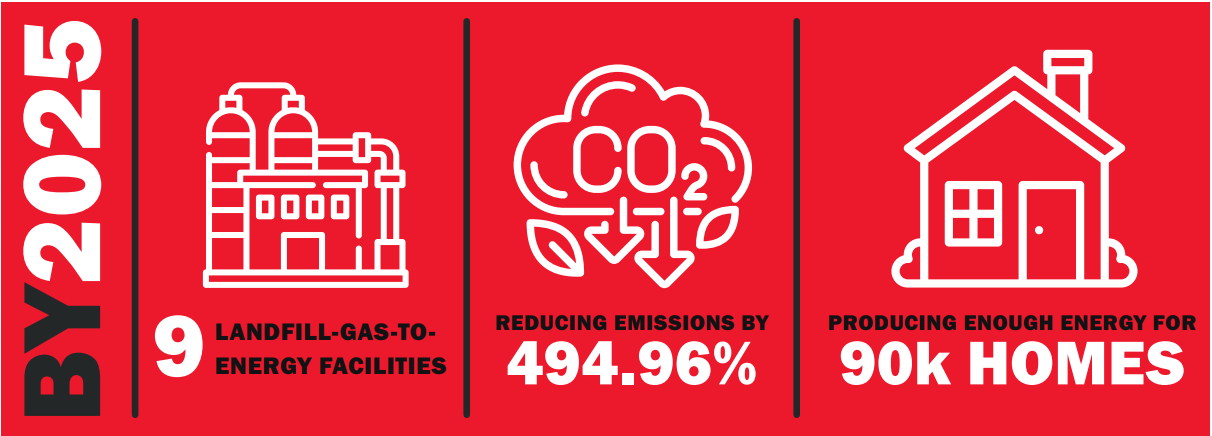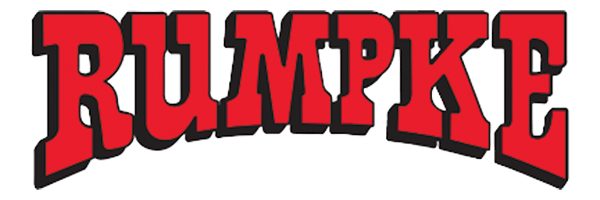Sustainability: Landfills
Green Energy
Rumpke operates 16 landfills and currently has more than 300 million cubic yards of permitted disposal capacity. At each of Rumpke’s operations, sustainability, recycling and reuse are top of mind and an integral part of daily and long-term planning.
Landfill gas recovery is a major focus for Rumpke. As trash decomposes, it releases methane and must be managed. Since 1986, when Rumpke was among the first in the country to build a landfill gas recovery system at Rumpke Sanitary Landfill in Cincinnati, Rumpke has partnered to build six landfill gas-to-energy systems throughout its landfill network. The systems are built in collaboration with Montauk, bp Archaea, Eastern Kentucky
Power Cooperative, EDL, and Opal. These facilities provide enough energy for more than 60,000 homes daily. Rumpke opened its seventh plant at its Montgomery County Landfill in 2024 and began construction on two additional plants, one at the Beech Hollow Landfill in Wellston, Ohio, and the other at the Pike Sanitation Landfill in Waverly, Ohio. These efforts serve to reduce greenhouse gases and mitigate landfill odors.
In all, Rumpke gas recovery systems include an intricate system of several hundred gas collection wells. About 300 of these use automated wellhead technology that utilizes solar power and further reduces emissions.

Down to the Last Drop
Being a recycling company since day one, Rumpke has strived to implement the best recycling practices at its landfills. Miles and miles of landfill pipes are used to move stormwater, gas and wastewater. Much of that pipe is provided by ADS (Advanced Drainage Systems) in Hilliard, Ohio. ADS uses Rumpke’s processed HDPE (High Density Polyethylene) to make new drainage pipe—some of the very pipes we use in our landfills.
Water that does not encounter waste in our landfills is also conserved. Stormwater is directed to sediment basins. The water from our sediment basins is used year-round to water down access roads and reduce dust.

At most landfills, our wheel washes are customized with water reuse systems to constantly clean and re-clean used water from the wash system to minimize new water usage. These water reuse systems conserve millions of gallons of water annually.
Modern landfill construction considers the impact on the surrounding environment, including wetlands. Rumpke maintains 22.17 acres of wetlands, in addition to past wetlands projects that no longer require monitoring. Today, Rumpke constructs wetlands by purchasing wetland credits from a “bank,” and in 2024, Rumpke purchased more than $3 million in wetland credits.
An EnTIREly Different Approach
Today’s landfill construction requires a specific liner system complete with separation barriers and drainage. Annually, Rumpke processes about two million tires and creates 2-inch by 2-inch shreds that are used for landfill construction. During 2024, Rumpke used about 50 tons of processed tires for landfill construction.

Getting Scrappy
Like the hauling line of business, the landfill line of business does a bit of scrapping of its own. All the parts that Rumpke uses on its dozers, dump trucks, tractors and water wagons are scrapped for recycling.
As Senior Area Engineer, sustainability is ensuring an environmentally and economically responsible solution for long-term disposal of solid wastes for future generations. This would include the design and development of solid waste transfer stations, solid waste landfills and material recovery facilities.
– David Murphy, Senior Area Engineer
